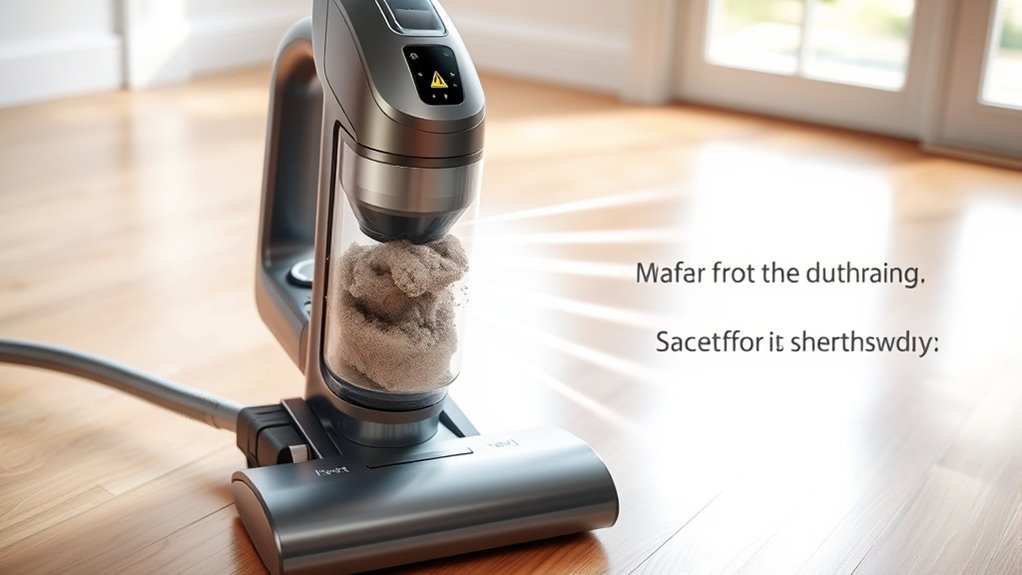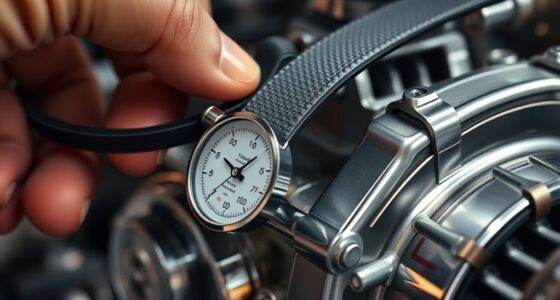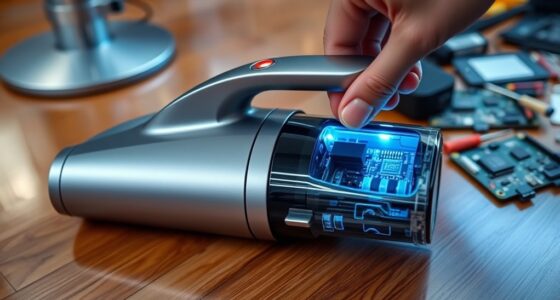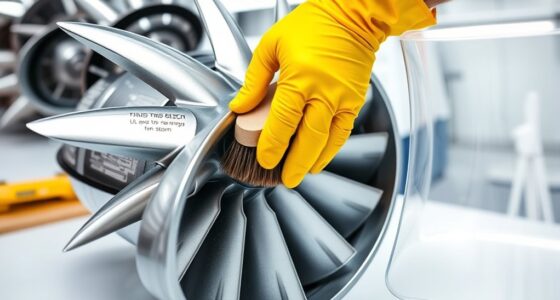To diagnose overheating before your vacuum shuts down, start by checking for signs like loud fan noises, unusual smells, or a rising temperature gauge. Inspect for blockages or debris in the brush roller and dustbin, which can restrict airflow. Make sure filters, vents, and cooling fans are clean. Also, verify internal wiring and motor conditions for damage. Staying alert to these indicators can help you prevent breakdowns—more tips await if you look further.
Key Takeaways
- Monitor dashboard alerts, temperature gauges, and unusual smells to detect early signs of overheating.
- Check for blockages, tangled debris, and airflow restrictions in the brush roller and dustbin area.
- Inspect the air filter, vents, and cooling fans for dirt buildup or obstructions that impair ventilation.
- Examine internal components, wiring, and motor for signs of overheating, burning smells, or unusual noises.
- Perform routine maintenance, including cleaning filters and fans, and avoid overloading the vacuum during extended use.
Recognizing the Signs of Overheating
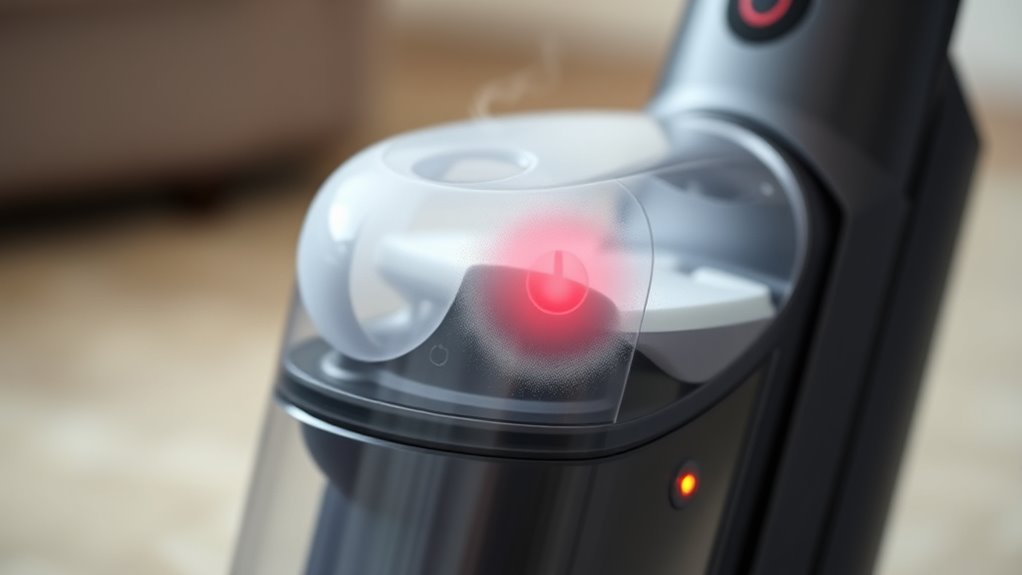
When your engine starts running hotter than normal, it’s a clear sign of overheating. You might notice overheating alerts on your dashboard or hear the fan kick in more frequently. Sensor malfunctions can also cause false overheating signals, making it tricky to identify the real issue. Keep an eye on the temperature gauge; if it climbs past the normal range, don’t ignore it. Unusual smells or steam escaping from under the hood are additional warning signs. If you notice these signs, take immediate action to prevent damage. Recognizing these early indicators helps you avoid costly repairs and keeps your engine running smoothly. Stay alert to overheating alerts and sensor performance to catch issues before they escalate. Additionally, understanding how automation in business can streamline maintenance processes may help you respond more efficiently to engine issues.
Checking for Blockages and Obstructions
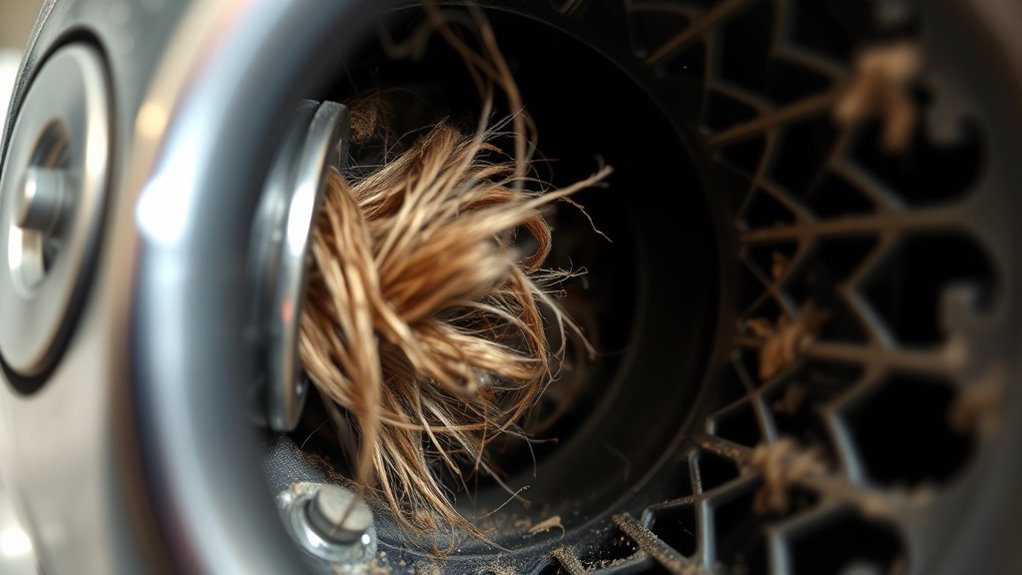
Blocked or obstructed airflow can substantially contribute to overheating. Begin by checking the brush roller area; hair, debris, and fibers often get tangled, restricting movement and airflow. Remove any blockages and ensure the brush roller spins freely. Next, examine the belt alignment—if the belt is misaligned or slipping, it can cause the motor to work harder, increasing heat. Make sure the belt is tight and properly aligned with the pulleys. Clear any obstructions around the belt and roller area to allow smooth operation. Regularly inspecting these components prevents overheating caused by airflow restrictions. Additionally, using a professional diagnostic can help identify underlying issues that may not be immediately visible. If you notice the vacuum overheating after cleaning these parts, consider further checks or professional servicing, but often, clearing blockages and aligning the belt resolve the issue.
Inspecting the Air Filter and Ventilation System
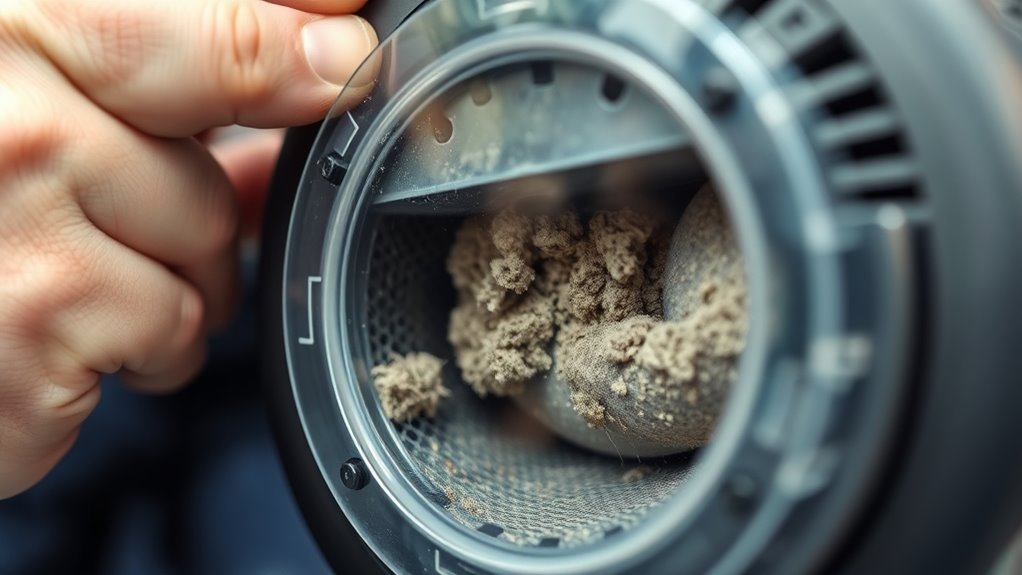
Start by checking your air filter to see if it’s dirty or clogged, as a blocked filter can cause overheating. Make sure there are no obstructions in the ventilation system that could restrict airflow. Clearing any blocks and replacing the filter if needed can often resolve overheating issues quickly. Additionally, ensure proper airflow around the unit for optimal performance to prevent overheating problems.
Check Air Filter Condition
A clogged or dirty air filter can considerably reduce airflow, causing your vehicle or appliance to overheat. When the filter is dirty, airflow efficiency drops, forcing the system to work harder and generate more heat. Check your air filter regularly, and if it looks clogged or discolored, it’s time for a filter replacement. A clean filter guarantees proper airflow, helping your appliance run cooler and more efficiently. Don’t ignore the condition of the filter, as neglecting it can lead to overheating and potential damage. Regular maintenance of the air filter not only improves performance but also extends the lifespan of your equipment. Monitoring air quality indicators helps determine when a filter replacement is necessary, ensuring your system operates optimally. Keep an eye on the filter’s condition and replace it promptly to maintain optimal ventilation and prevent overheating issues.
Clear Ventilation Blocks
Ensuring your ventilation pathways are clear is essential after checking the air filter. Blockages can cause your vacuum to overheat and shut down prematurely. Inspect the vent openings and remove any debris or lint buildup. Check the brush roller area for tangled hair or debris that could impede airflow. Also, verify that the belt tension is correct; a loose belt can reduce brush roller efficiency, increasing motor strain. Ensure the vent pathways are unobstructed and that the brush roller spins freely. Regular maintenance helps prevent overheating issues and prolongs the lifespan of your vacuum.
Examining the Motor and Internal Components

Have you checked the motor and internal components for signs of overheating or damage? Start by inspecting the motor winding for any discoloration, scorching, or burnt smell, which indicate overheating. Carefully examine the internal wiring for frayed, melted, or loose connections that could cause electrical issues or heat buildup. Listen for unusual noises like grinding or humming, which can signal internal problems. Feel the motor housing for excess heat—if it’s unusually hot to touch, that’s a warning sign. Check for debris or dust accumulation inside the motor area, as these can restrict airflow and cause overheating. Regular maintenance and cleaning can also prevent airflow restrictions that lead to overheating. Addressing these issues promptly can prevent further damage and ensure your vacuum operates smoothly without shutting down due to internal overheating.
Monitoring Vacuum Usage and Operating Conditions
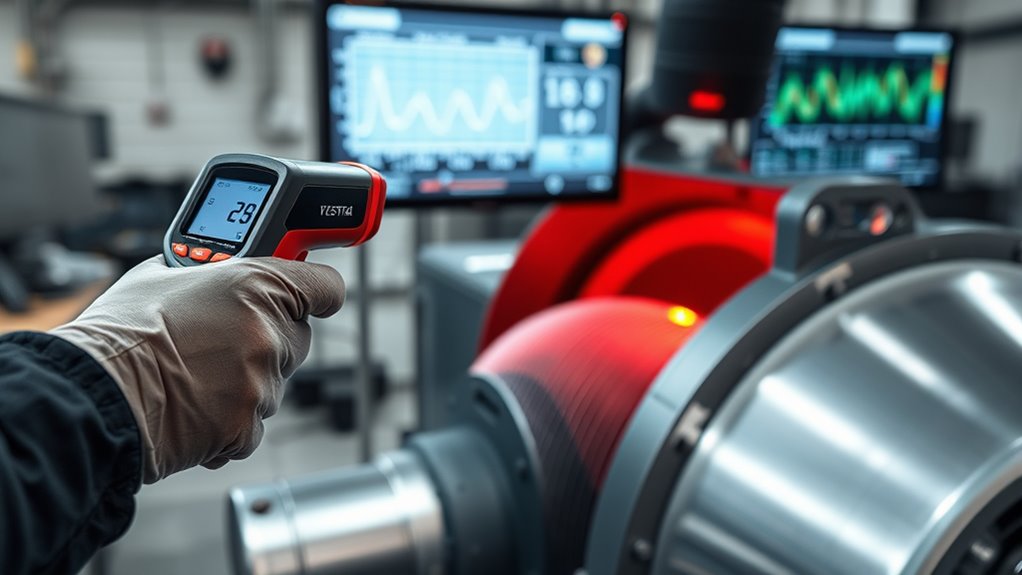
Monitoring your vacuum’s usage and operating conditions is essential to prevent overheating. Regularly observe how long you run it and avoid overusing it continuously. Implementing proper maintenance routines, like cleaning filters and emptying the bin, helps reduce strain on the motor. Your user behavior, such as pushing the vacuum too hard or working on thick debris, can also cause overheating. To illustrate, consider this table:
| Usage Pattern | Impact on Overheating | Recommended Action |
|---|---|---|
| Continuous use >30 mins | Increases motor temperature | Take breaks and let it cool |
| Vacuuming thick debris | Strains motor components | Use appropriate settings |
| Overfilled bin | Reduces airflow | Empty regularly |
| Neglected maintenance | Causes overheating | Follow routine upkeep |
| Improper handling | Damages internal parts | Use gentle, proper technique |
Additionally, consistent maintenance routines are vital for ensuring the longevity of your vacuum and preventing overheating issues.
Testing the Thermostat and Thermal Cutoff
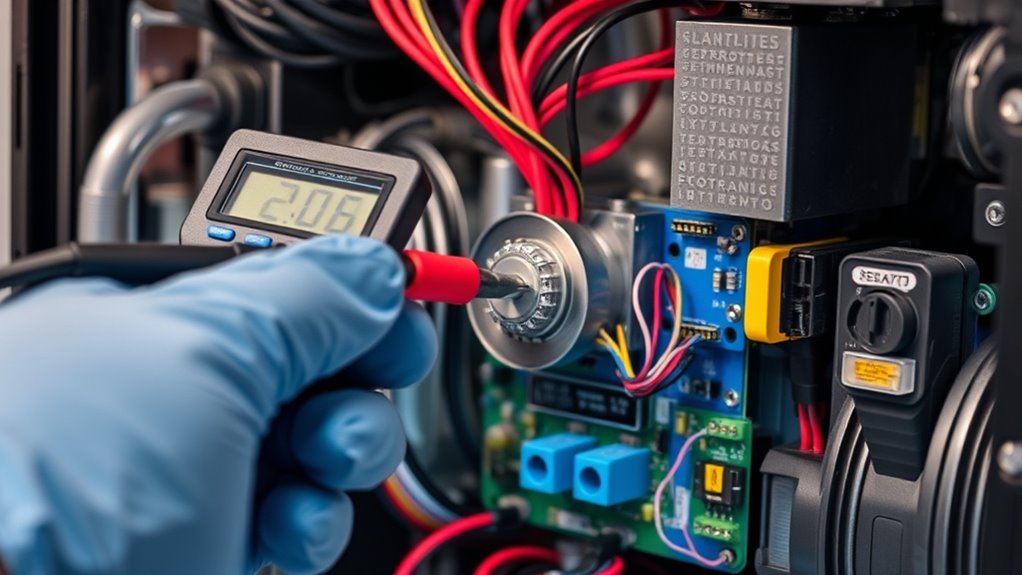
When you notice your vacuum overheating despite proper usage, testing the thermostat and thermal cutoff can help identify potential issues. Begin by checking the thermostat calibration with a multimeter to ensure it’s functioning correctly. If the thermostat isn’t calibrated properly, it may cause overheating or premature shutdowns. Next, perform thermal cutoff testing by disconnecting the vacuum from power and locating the thermal cutoff switch. Use a multimeter to test for continuity; if there’s no continuity, the switch is faulty and needs replacement. Proper thermal cutoff testing confirms whether the safety device is working correctly. Addressing these components helps prevent overheating and unnecessary shutdowns, ensuring your vacuum operates safely and efficiently. Regular testing can catch issues early before more extensive damage occurs. Additionally, understanding the thermal cutoff functioning and its role in safety can help you better maintain your appliance.
Maintaining Proper Bag and Dustbin Management
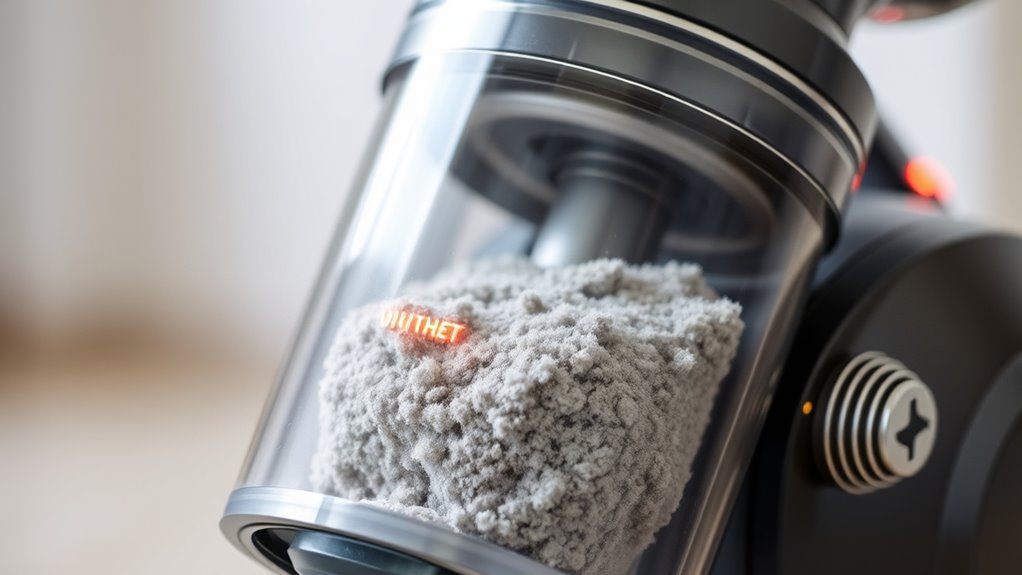
Make certain to empty your dustbin regularly to prevent buildup that can cause overheating. Using the correct size bag guarantees a snug fit, reducing strain on your appliance. Proper management of bags and dustbins keeps your system running efficiently and avoids unnecessary heat.
Empty Dustbin Regularly
Regularly emptying your dustbin is essential to prevent overheating issues in your vacuum cleaner. When the dustbin reaches its capacity, airflow is restricted, causing the motor to work harder and potentially overheat. Maintaining good dustbin hygiene ensures debris isn’t packed too tightly, which can also impede airflow. Check the dustbin frequently and clear it before it becomes full. This simple step helps your vacuum operate efficiently and reduces the risk of it shutting down prematurely. Always follow your manufacturer’s guidelines on dustbin capacity and cleaning intervals. By keeping the dustbin clean and not overfilled, you help maintain proper airflow, preventing overheating and prolonging your vacuum’s lifespan. Regular maintenance of dustbin hygiene is a key part of troubleshooting overheating problems. Additionally, understanding the importance of airflow management can help you optimize your vacuum’s performance and avoid overheating issues.
Use Proper Bag Size
Using the correct bag size is essential for preventing overheating in your vacuum cleaner. A proper bag ensures ideal airflow and prevents motor strain. When your bag is too small or overfilled, airflow becomes restricted, causing the motor to work harder and overheat. Always check your vacuum’s recommended bag capacity and replace it before it’s completely full. Proper bag management maintains consistent suction and reduces wear on internal components. Additionally, selecting appropriate aftermarket parts can help optimize performance and airflow. Keep an eye on the bag’s fill indicator if available, and regularly inspect the bag for tears or damage. Maintaining the proper bag size helps prevent overheating and prolongs your vacuum’s lifespan.
Troubleshooting Electrical and Power Supply Issues
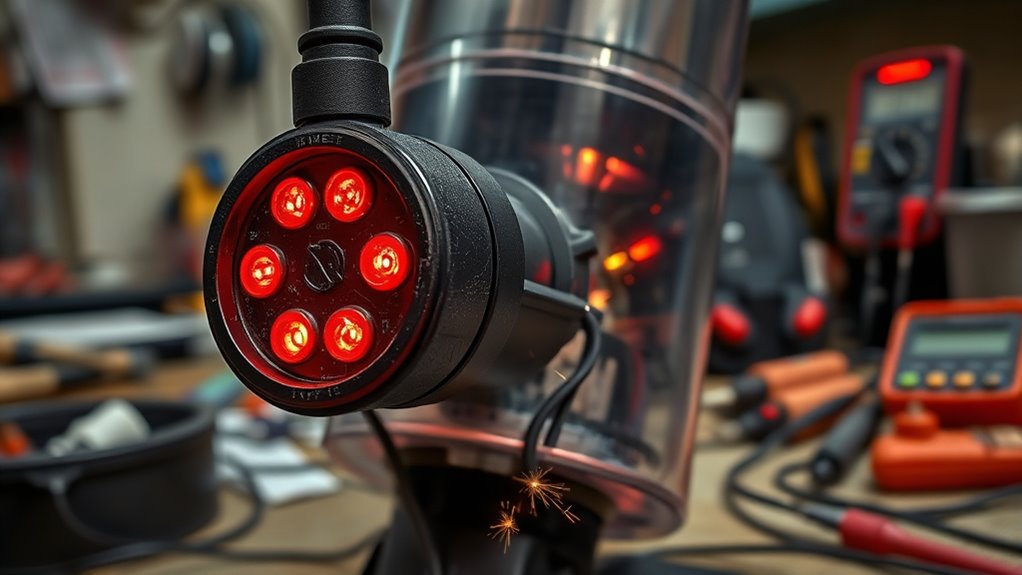
Electrical and power supply issues are often the root cause of overheating in electronic devices. If your vacuum is overheating, start by checking the power supply to guarantee it’s providing consistent voltage. A faulty or unstable power source can cause the motor to work harder, generating excess heat. Next, inspect the electrical connections, including plugs, cords, and internal wiring, for signs of damage or looseness. Loose or corroded connections can cause electrical resistance, leading to overheating. Make sure all connections are secure and free of debris. If you notice any frayed cords or burnt smells, replace damaged parts immediately. Ensuring a stable power supply and solid electrical connections helps prevent overheating and extends your vacuum’s lifespan.
Preventative Measures to Avoid Overheating

To prevent overheating, it’s vital to adopt proactive habits that keep your vacuum running smoothly. Regularly clean the cooling fans to guarantee unobstructed airflow, preventing heat buildup. Check the heat sensors periodically for any malfunctions, as faulty sensors may fail to signal overheating. Avoid overloading the vacuum, which strains components and increases heat. Confirm vents are free of dust and debris, allowing proper heat dissipation. Using the vacuum in a well-ventilated area helps maintain ideal temperature levels. Additionally, monitor the device during extended use to catch early signs of overheating. Implementing these measures reduces the risk of shutdowns and prolongs your vacuum’s lifespan.
- Keep cooling fans free of dust and debris
- Regularly test heat sensors for accuracy
- Avoid overloading the vacuum during cleaning
- Use in well-ventilated spaces
- Perform routine maintenance checks
Frequently Asked Questions
How Do I Reset My Vacuum After It Overheats?
When your vacuum overheats, you’ll need to reset it to restore proper function. First, turn it off and unplug it, allowing it to cool down completely. Check for blockages or debris that could cause overheating, and clear them during your vacuum maintenance. Once cooled, press the reset button if your model has one. Regular overheating prevention, like cleaning filters and avoiding prolonged use, helps keep your vacuum running smoothly.
Can Using My Vacuum on Different Surfaces Cause Overheating?
Using your vacuum on different surfaces can cause overheating, especially if it’s surface sensitive. Thicker carpets or rough surfaces may restrict airflow, reducing heat dissipation. When the vacuum works harder on certain surfaces, it generates more heat. To prevent shutdowns, switch to appropriate settings for each surface, and make sure vents are clear. Proper surface sensitivity adjustments help maintain ideal heat dissipation, avoiding overheating and keeping your vacuum running smoothly.
How Long Should I Let My Vacuum Cool Down Before Restarting?
Think of your vacuum as a runner catching their breath after a sprint. Usually, you should let it cool down for about 15 to 30 minutes before restarting. This cooling time allows the motor to recover and prevents damage. Follow the restart guidelines in your user manual, as some models may need a longer break. Patience now guarantees your vacuum stays healthy and ready for the next cleaning marathon.
Are There Specific Vacuum Models More Prone to Overheating?
Some vacuum models are more prone to overheating due to design or motor quality, so it’s smart to research specific models. Heavier or more powerful vacuums often have higher overheating susceptibility, especially if used extensively without breaks. Check user reviews and manufacturer specs for insights. If you notice frequent shutdowns, consider upgrading to a model with better heat management features, helping you avoid overheating issues altogether.
What Are the Long-Term Effects of Frequent Overheating on My Vacuum?
Frequent overheating can considerably shorten your vacuum’s lifespan by causing motor damage over time. When your vacuum regularly gets too hot, it strains the motor, leading to early failure or reduced efficiency. You might notice decreased suction or strange noises. To protect your investment, avoid overuse and ensure proper maintenance. Address overheating issues promptly to prevent long-term damage and extend your vacuum’s durability.
Conclusion
By staying attentive to signs of overheating and performing regular maintenance, you can keep your vacuum running smoothly. Remember, a stitch in time saves nine—address issues early before they cause bigger problems. Don’t ignore the warning signs, and take proactive steps to prevent overheating. With proper care and vigilance, your vacuum will serve you well for years to come, proving that a little effort now saves a lot of trouble later.

